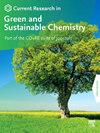Evaluation of Corynocarpus laevigatus extract as a green corrosion retardant for mild steel in acidic media: A combined gravimetric, gasometric and electrochemical methods
Q2 Materials Science
Current Research in Green and Sustainable Chemistry
Pub Date : 2025-01-01
DOI:10.1016/j.crgsc.2025.100447
引用次数: 0
Abstract
The corrosion inhibition by the methanolic extract of Corynocarpus laevigatus leaves on mild steel within acidic environments was evaluated utilizing gravimetric, gasometric, and electrochemical methodologies. The findings indicate that the extracts serve as an effective corrosion inhibitor in both H2SO4 and HCl aqueous solutions. The extract exhibited optimum inhibition efficiencies of 88.64 %, 71.12 %, and 77.60 % in H2SO4, and 88.89 %, 67.96 %, and 85.55 % in HCl, respectively. The inhibition efficiency increased with higher extract concentrations but decreased with increasing temperature and exposure time in both media. Also, the rate of hydrogen evolution increased with rising temperature in both media. Adsorption studies revealed that the inhibitor's average activation energy (Ea) values were 71.23 kJ/mol and 137.59 kJ/mol for H2SO4 and HCl media, respectively. The extract followed the Langmuir isotherm model, indicating monolayer adsorption of the phytochemical components onto the mild steel surface. Physical adsorption was dominant in H2SO4, as evidenced by decreasing activation energy (Ea) values with increasing temperature. In contrast, chemical adsorption was observed in HCl. The strong adsorption of phytochemicals present in the extract onto the steel surface was identified as the primary mechanism for corrosion inhibition. This study provides valuable insights into the dual adsorption mechanisms of Corynocarpus laevigatus in different acidic media which underscores its potential as a sustainable and effective corrosion inhibitor in acidic environments.
山菖蒲提取物作为酸性介质中低碳钢绿色缓蚀剂的评价:用重量、气相和电化学相结合的方法
采用重量法、气相法和电化学方法评价了山菖蒲叶甲醇提取物在酸性环境下对低碳钢的缓蚀作用。结果表明,该提取物在H2SO4和HCl水溶液中均能有效抑制腐蚀。该提取物对H2SO4的抑菌率分别为88.64%、71.12%和77.60%,对HCl的抑菌率分别为88.89%、67.96%和85.55%。抑制效果随萃取物浓度的增加而增加,但随温度和暴露时间的增加而降低。在两种介质中,随着温度的升高,析氢速率增加。吸附研究表明,该抑制剂对H2SO4和HCl介质的平均活化能(Ea)分别为71.23 kJ/mol和137.59 kJ/mol。提取液遵循Langmuir等温线模型,表明植物化学成分在低碳钢表面的单层吸附。H2SO4以物理吸附为主,随温度升高活化能(Ea)值降低。相反,在HCl中观察到化学吸附。提取物中植物化学物质在钢表面的强吸附被确定为缓蚀的主要机制。本研究为深入了解山菖蒲在不同酸性介质中的双重吸附机制提供了有价值的见解,强调了其在酸性环境中作为一种可持续有效的缓蚀剂的潜力。
本文章由计算机程序翻译,如有差异,请以英文原文为准。
求助全文
约1分钟内获得全文
求助全文
来源期刊

Current Research in Green and Sustainable Chemistry
Materials Science-Materials Chemistry
CiteScore
11.20
自引率
0.00%
发文量
116
审稿时长
78 days
 求助内容:
求助内容: 应助结果提醒方式:
应助结果提醒方式:


